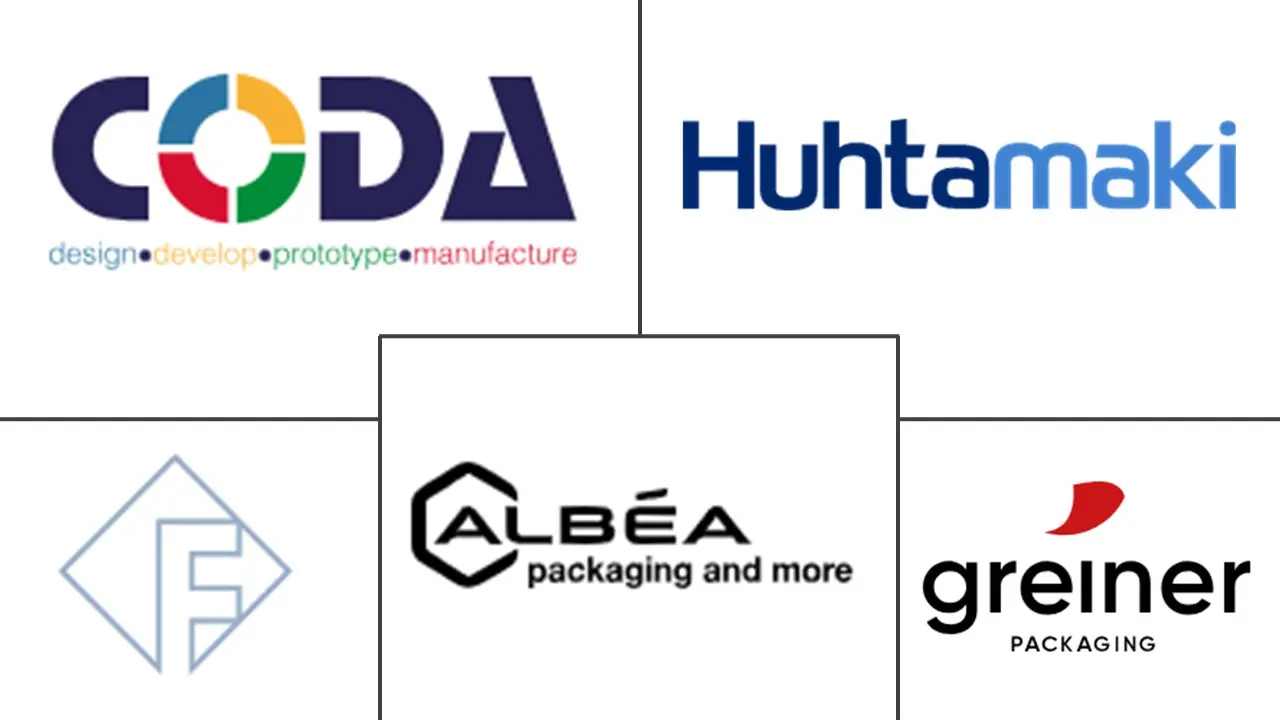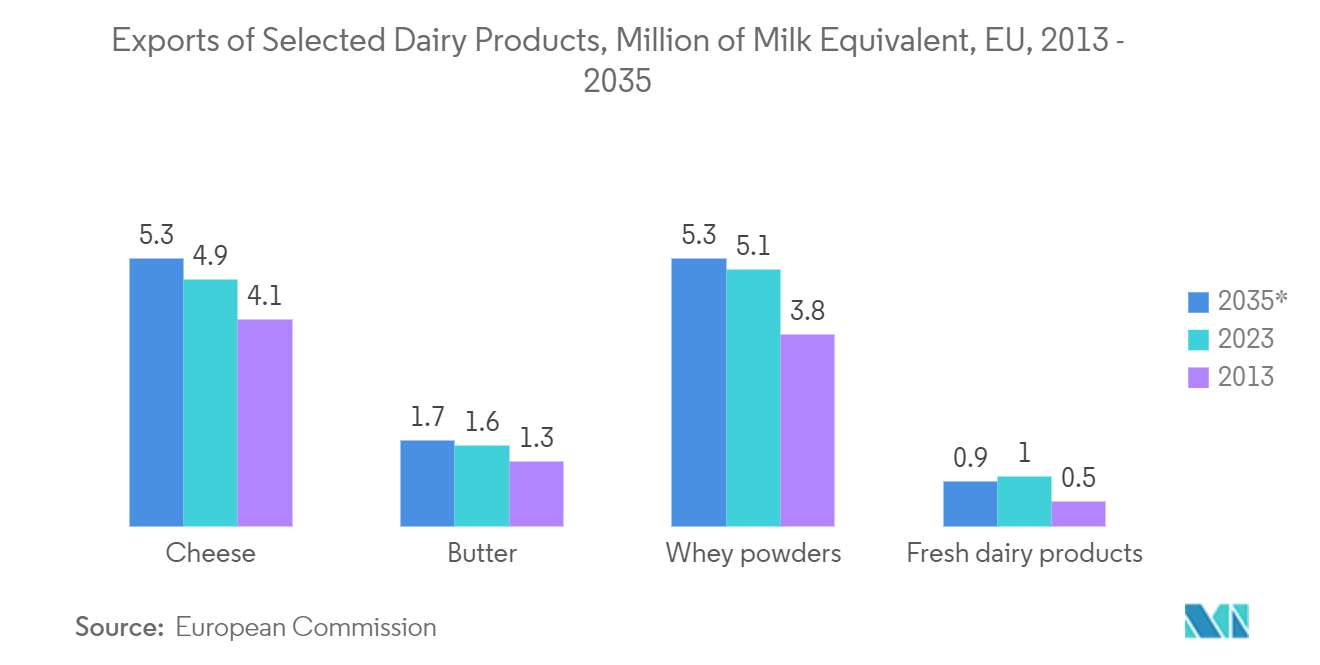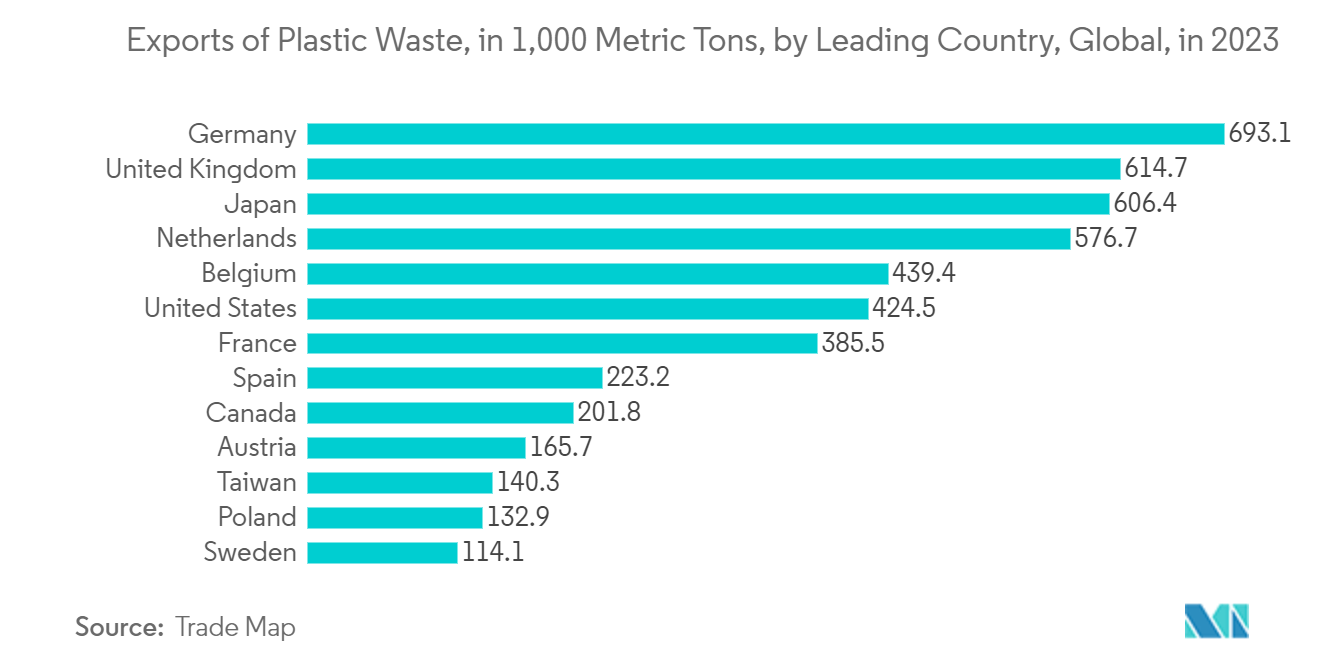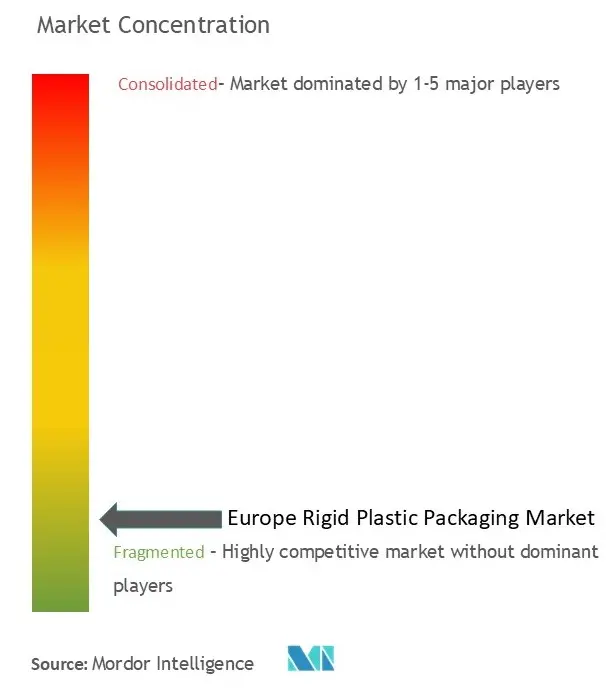Europe Rigid Plastic Packaging Market Size

| Study Period | 2019 - 2029 |
| Base Year For Estimation | 2023 |
| Market Size (2024) | USD 69.14 Billion |
| Market Size (2028) | USD 77.32 Billion |
| CAGR (2024 - 2029) | 2.26 % |
| Market Concentration | Low |
Major Players
*Disclaimer: Major Players sorted in no particular order |
Europe Rigid Plastic Packaging Market Analysis
The Europe Rigid Plastic Packaging Market size is estimated at USD 69.14 billion in 2024, and is expected to reach USD 77.32 billion by 2028, growing at a CAGR of 2.26% during the forecast period (2024-2028).
- There is a growing consumer preference for convenient and durable packaging, which is provided by rigid plastic. This includes ease of use, longer shelf life, and adequate product protection. Many rigid plastic packaging solutions are now designed to be more easily recyclable, aligning with the EU's sustainability goals. For instance, with operations in various European countries, Plastipak and Alpla focus on producing PET containers and bottles designed for recyclability and sustainability. The improvements in recycling processes and the development of more sustainable plastic materials address environmental concerns, thereby driving the demand in the market studied.
- European regulations favoring recycling and reducing environmental impact push manufacturers to adopt more sustainable packaging practices. This includes compliance with packaging waste directives and eco-design requirements. According to the EU Commission's Packaging and Packaging Waste Directive, the recycling targets for all packaging are 65% by December 2025 and 70% by December 2030.
- The European rigid plastic packaging market is largely driven by the growth of the pharmaceutical industry, which depends more on sophisticated packaging solutions to meet strict regulations, guarantee product safety, and meet the growing demand for pharmaceutical products. The development of new pharmaceuticals and cures, an aging population, and rising healthcare costs are some of the causes driving the pharmaceutical industry's growth, all of which need strong and dependable packaging solutions.
- The European rigid plastic packaging market is mostly driven by technological developments in packaging materials, which allow the sector to better protect products, adapt to changing customer needs, and comply with strict environmental requirements. These developments, which are changing the rigid plastic packaging market, include the creation of new materials, enhanced production techniques, and the incorporation of smart technology.
- The European rigid plastic packaging market faces several challenges, including growing consumer demand for environmentally friendly packaging options, regulatory pressures, and developments in alternative materials. One of the biggest threats is the competition from alternative packaging materials. Paper, glass, and biodegradable materials are among the materials the market is moving toward as customers and authorities grow more ecologically sensitive. Producers of rigid plastic packaging are under pressure from this change to innovate and adapt to stay competitive in the market.
- The COVID-19 pandemic led to a surge in demand for packaging in the food and beverage, pharmaceutical, and healthcare sectors. Rigid plastic packaging was crucial for ensuring product safety and hygiene, especially for medical supplies, sanitizers, and packaged foods. The rise in online shopping during the pandemic also increased the demand for durable packaging solutions suitable for shipping, boosting the need for rigid plastic packaging.
Europe Rigid Plastic Packaging Market Trends
The Food Segment is Expected to Hold a Significant Market Share
- In the fresh food sector, market vendors across Europe are channeling investments into innovations and new product launches, bolstering the regional food packaging industry. These companies provide a diverse range of solutions, including rigid foils for form-fill-seal processes and thermoformed packs made from PET, PP, PLA, and PS that ensure food preservation and protection.
- For instance, in April 2024, Denmark's Faerch Group, known for its sustainable food packaging solutions in ready meals, protein, food-to-go, and dairy, announced that it would process used PET trays sourced from household waste. With an input capacity of 60,000 tonnes, this initiative spans Benelux, Germany, and Sweden. Faerch's goal is to make the 3 billion rigid food packaging items it sells annually 'truly circular.' Collaborating with Tesco, Faerch pioneered a PET recycling initiative, successfully reintegrating 30% recycled tray content from European curbside waste into its chilled ready-meal packaging.
- Other players, such as Klöckner Pentaplast Group, a German packaging company, have unveiled a food tray made entirely from recycled materials. This innovation utilizes PET waste sourced from their Tray2Tray closed-loop initiative. By the close of 2025, Klöckner Pentaplast aims to source a minimum of 30% of the recycled materials in its packaging from the initiative. In a parallel move, Finland's Metsä Group revealed that it was evaluating the feasibility of establishing a commercial-scale factory for its Muoto wood fiber products, which are designed as renewable and recyclable substitutes for plastic food packaging.
- According to the European Pet Food Industry Federation (FEDIAF), Europe is currently home to 352 million pets. FEDIAF highlights that in Italy, the pet food market has seen growth surpassing that of the broader FMCG sector in terms of value, volume, and pricing. In addition, there is a notable surge in the fresh and frozen pet food segment, driven by pet owners' desires to provide premium care, including meal preparation.
- Furthermore, in the meat and fish sectors, there is an increasing demand for a diverse range of rigid packaging solutions that prioritize functional attributes like transparency, effective sealing, and product preservation. Notably, trays designed for modified atmosphere packaging are in demand as they extend freshness. This trend has prompted vendors to broaden their offerings, catering to meat, chicken, sliced products, fish, and seafood markets across Europe.
- According to the European Commission, the domestic market is projected to remain the primary outlet for the EU’s milk production, accounting for 88% by 2035. Consumer preferences are evolving, especially among younger demographics leaning toward dairy products with reduced fat and sugar content and those catering to food intolerances. Furthermore, the health needs of an aging population and lifestyle choices are anticipated to bolster the demand for fortified, functional products and plant-based alternatives.
- The production of whey powder in the EU is poised for growth, buoyed by robust global demand. This demand is primarily fueled by its increasing use in food and the emergence of new product lines emphasizing nutritional and health benefits. Projections indicate a 0.3% annual increase in EU whey production and a 0.4% annual rise in EU whey exports, extending to 2035.

Germany is Expected to Hold a Significant Market Share
- Germany is significantly contributing to the demand in the rigid plastic packaging market. Germany’s robust industrial and manufacturing sectors, including automotive, electronics, and consumer goods, require substantial amounts of rigid plastic packaging for product protection and distribution. The country also has a large and diverse food and beverage industry, which relies heavily on rigid plastic packaging for its products, including bottles, containers, and jars.
- Germany is increasingly adopting rigid plastic packaging solutions, owing to the several developments taking place in the country by the solution providers and different end users. The typical consumer perception of “Made in Germany” goods has provided a better performance space for the flexible packaging companies in the region.
- The German government has introduced several stringent regulations for the plastics packaging industry. While PET bottles are standard in multiple segments, beverages, cosmetics, sanitary products, and detergents are predominantly sold in polyethylene (PE) bottles. In 2023, Germany had a significant collection rate for PET bottles at 98%.
- According to Statistisches Bundesamt, the projected revenue from manufacturing plastic products in Germany will amount to approximately USD 104.38 billion by 2025. According to Trade Map, in 2023, Germany led the globe as the top exporter of plastic waste, sending out shipments that exceeded 693 thousand metric tons. Plastic containers are becoming essential in various end-user industries. New filling technologies and the emergence of heat-resistant packaging material opened new possibilities and options in the market.
- German manufacturers are well-informed and increasingly becoming sensitive toward recyclability. They are gravitating toward this business decision in Germany and are increasingly introducing eco-friendly and recyclable plastics in the market. In February 2024, Germany launched a set of new standards for recyclable plastics to develop a comprehensive guide to increase trade in recyclable plastic. For the first time, the country focused on polyamide as a raw material, covering both waste and recycling. This opens the possibility for rigid plastic with the help of significantly more digitization within the circular economy.
- During the same time, in February 2024, 23 Oaks Investments partnered with LyondellBasell, a chemical company. They formed a joint venture, Source One Plastics, to initiate a plastic waste sorting and recycling facility in Germany. The new unit treats waste that is difficult to recycle after consumption, including mixed plastic packaging and polyolefins, which would otherwise be burned. The processing capacity of the new unit is 70,000 MT, equivalent to the plastic waste of 1.5 million people in Germany per year. Such constant initiatives are expected to bolster the demand for rigid plastic nationwide in the coming years.

Europe Rigid Plastic Packaging Industry Overview
The European rigid plastic packaging market is highly fragmented with the presence of major players like Coda Plastics, Frapak, Huhtamaki OYJ, Greiner Packaging (Greiner AG), and Albéa Group. Players in the market are adopting strategies such as partnerships and acquisitions to enhance their product offerings and gain sustainable competitive advantage.
- September 2023: French cosmetics brand L'Occitane partnered with cosmetic tube supplier Albéa Tubes to redesign the packaging of its 30 ml hand cream collection. The new packaging solution features an all-plastic laminate and an Association of Plastic Recyclers-certified Greenleaf tube with a multilayer sleeve in high-density polyethylene (HDPE).
Europe Rigid Plastic Packaging Market Leaders
-
Coda Plastics
-
Frapak
-
Huhtamaki OYJ
-
Greiner Packaging (Greiner AG)
-
Albéa Group
*Disclaimer: Major Players sorted in no particular order

Europe Rigid Plastic Packaging Market News
- June 2024: CARBIOS teamed up with cosmetics brands L'OCCITANE en Provence and Pinard Beauty Pack to create a polyethylene terephthalate (PET) bottle made entirely through enzymatic depolymerization. This clear bottle is designated for the brand's Amande range shower oil. The journey of this 100% recycled PET bottle commenced with sourcing PET waste from local collection points, feeding into CARBIOS' industrial demonstrator located in Clermont-Ferrand, France.
- May 2024: ALPLA unveiled a recyclable PET wine bottle, boasting significant benefits over conventional glass counterparts. This cutting-edge packaging is notably lighter, slashes carbon emissions by 50%, and offers financial savings. Crafted from recyclable materials, the bottle comes in two distinct sizes, with a pilot customer in Austria already on board.
- April 2024: Amcor, a leading name in responsible packaging solutions, rolled out its one-liter polyethylene terephthalate (PET) bottle for carbonated soft drinks (CSDs), made entirely from 100% post-consumer recycled (PCR) content. This pivotal stock option aims to empower customers to meet their sustainability goals. Amcor Rigid Packaging’s expansion of its offerings with this 100% PCR bottle for CSDs is a testament to its innovative spirit in the packaging industry, underscoring its commitment to responsible packaging.
Europe Rigid Plastic Packaging Market Report - Table of Contents
1. INTRODUCTION
- 1.1 Study Assumptions and Market Definition
- 1.2 Scope of the Study
2. RESEARCH METHODOLOGY
3. EXECUTIVE SUMMARY
4. MARKET INSIGHTS
- 4.1 Market Overview
-
4.2 Industry Attractiveness - Porter's Five Forces Analysis
- 4.2.1 Bargaining Power of Suppliers
- 4.2.2 Bargaining Power of Buyers
- 4.2.3 Threat of New Entrants
- 4.2.4 Threat of Substitutes
- 4.2.5 Intensity of Competitive Rivalry
5. MARKET DYNAMICS
-
5.1 Market Drivers
- 5.1.1 Expansion of the Pharmaceutical Industry
- 5.1.2 Technological Advancements in Packaging Materials
-
5.2 Market Challenges
- 5.2.1 Rising Competition from Alternative Packaging Materials
- 5.2.2 Limited Infrastructure for Plastic Waste Management
6. MARKET SEGMENTATION
-
6.1 By Product
- 6.1.1 Bottles and Jars
- 6.1.2 Trays and Containers
- 6.1.3 Caps and Closures
- 6.1.4 Intermediate Bulk Containers (IBCS)
- 6.1.5 Drums
- 6.1.6 Pallets
- 6.1.7 Other Product Types
-
6.2 By Material
- 6.2.1 Polyethylene (PE)
- 6.2.2 Polyethylene Terephthalate (PET)
- 6.2.3 Polypropylene (PP)
- 6.2.4 Polystyrene (PS) and Expanded Polystyrene (EPS)
- 6.2.5 Polyvinyl Chloride (PVC)
- 6.2.6 Other Rigid Plastic Packaging Materials
-
6.3 By End-user Industry
- 6.3.1 Food
- 6.3.2 Beverage
- 6.3.3 Healthcare
- 6.3.4 Cosmetics and Personal Care
- 6.3.5 Industrial
- 6.3.6 Building and Construction
- 6.3.7 Automotive
- 6.3.8 Other End-user Industries
-
6.4 By Country***
- 6.4.1 United Kingdom
- 6.4.2 Germany
- 6.4.3 France
- 6.4.4 Italy
- 6.4.5 Spain
- 6.4.6 Poland
7. COMPETITIVE LANDSCAPE
-
7.1 Company Profiles*
- 7.1.1 Coda Plastics
- 7.1.2 Frapak
- 7.1.3 Huhtamaki OYJ
- 7.1.4 Greiner Packaging (Greiner AG)
- 7.1.5 Albéa Group
- 7.1.6 Schutz GmbH & Co. KGaA
- 7.1.7 Q-Pall PV
- 7.1.8 WERIT-Kunststoffwerke W. Schneider GmbH & Co. KG
- 7.1.9 FDL Packaging Ltd
- 7.1.10 ActiPack
8. INVESTMENT ANALYSIS
9. MARKET OPPORTUNITIES AND FUTURE TRENDS
** Subject To AvailablityEurope Rigid Plastic Packaging Industry Segmentation
The market study tracks the demand for rigid plastic packaging products catering to the demand in the food, foodservice, beverage, healthcare, personal care, and cosmetic industries, industrial, building and construction, automotive, and other end-user industries. Rigid plastics can be of different grades and different material combinations based on the type of product being packed, like polyethylene, polypropylene, polyvinyl chloride, polyethylene terephthalate, bioplastics, and other materials.
The European rigid plastic packaging market is segmented by product (bottles and jars, trays and containers, caps and closures, intermediate bulk containers (IBCS), drums, pallets, and other product types), material (polyethylene (PE), polyethylene terephthalate (PET), polypropylene (PP), polystyrene (PS) and expanded polystyrene (EPS), polyvinyl chloride (PVC), other rigid plastic packaging materials), end-user industry (food, beverage, healthcare, cosmetics and personal care, industrial, building and construction, automotive, other end-user industries), and country (the United Kingdom, Germany, France, Italy, Spain, Poland, Rest of Europe). The report offers market forecasts and size in value terms in USD for all the above segments.
| By Product | Bottles and Jars |
| Trays and Containers | |
| Caps and Closures | |
| Intermediate Bulk Containers (IBCS) | |
| Drums | |
| Pallets | |
| Other Product Types | |
| By Material | Polyethylene (PE) |
| Polyethylene Terephthalate (PET) | |
| Polypropylene (PP) | |
| Polystyrene (PS) and Expanded Polystyrene (EPS) | |
| Polyvinyl Chloride (PVC) | |
| Other Rigid Plastic Packaging Materials | |
| By End-user Industry | Food |
| Beverage | |
| Healthcare | |
| Cosmetics and Personal Care | |
| Industrial | |
| Building and Construction | |
| Automotive | |
| Other End-user Industries | |
| By Country*** | United Kingdom |
| Germany | |
| France | |
| Italy | |
| Spain | |
| Poland |
Europe Rigid Plastic Packaging Market Research Faqs
How big is the Europe Rigid Plastic Packaging Market?
The Europe Rigid Plastic Packaging Market size is expected to reach USD 69.14 billion in 2024 and grow at a CAGR of 2.26% to reach USD 77.32 billion by 2028.
What is the current Europe Rigid Plastic Packaging Market size?
In 2024, the Europe Rigid Plastic Packaging Market size is expected to reach USD 69.14 billion.
Who are the key players in Europe Rigid Plastic Packaging Market?
Coda Plastics, Frapak, Huhtamaki OYJ, Greiner Packaging (Greiner AG) and Albéa Group are the major companies operating in the Europe Rigid Plastic Packaging Market.
What years does this Europe Rigid Plastic Packaging Market cover, and what was the market size in 2023?
In 2023, the Europe Rigid Plastic Packaging Market size was estimated at USD 67.58 billion. The report covers the Europe Rigid Plastic Packaging Market historical market size for years: 2019, 2020, 2021, 2022 and 2023. The report also forecasts the Europe Rigid Plastic Packaging Market size for years: 2024, 2025, 2026, 2027, 2028 and 2029.
Europe Rigid Plastic Packaging Industry Report
Statistics for the 2024 Europe Rigid Plastic Packaging market share, size and revenue growth rate, created by Mordor Intelligence™ Industry Reports. Europe Rigid Plastic Packaging analysis includes a market forecast outlook to for 2024 to 2029 and historical overview. Get a sample of this industry analysis as a free report PDF download.



